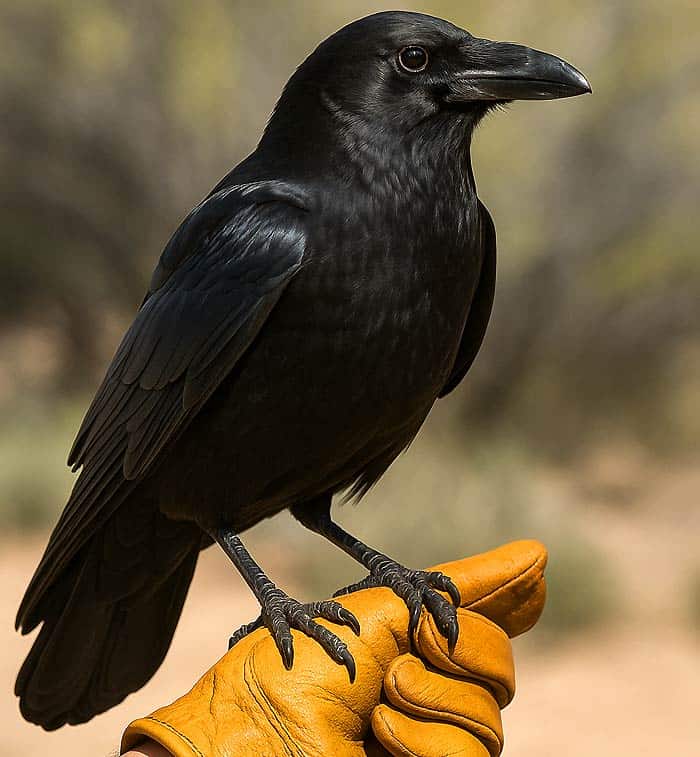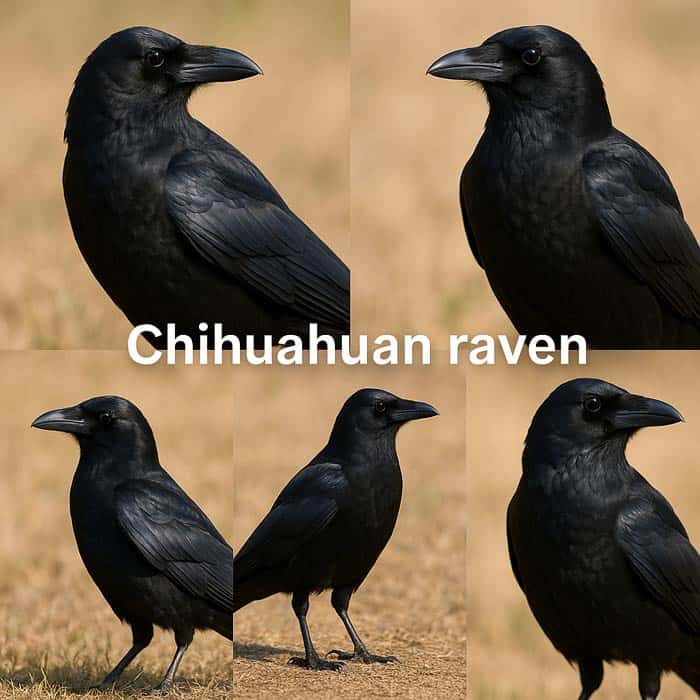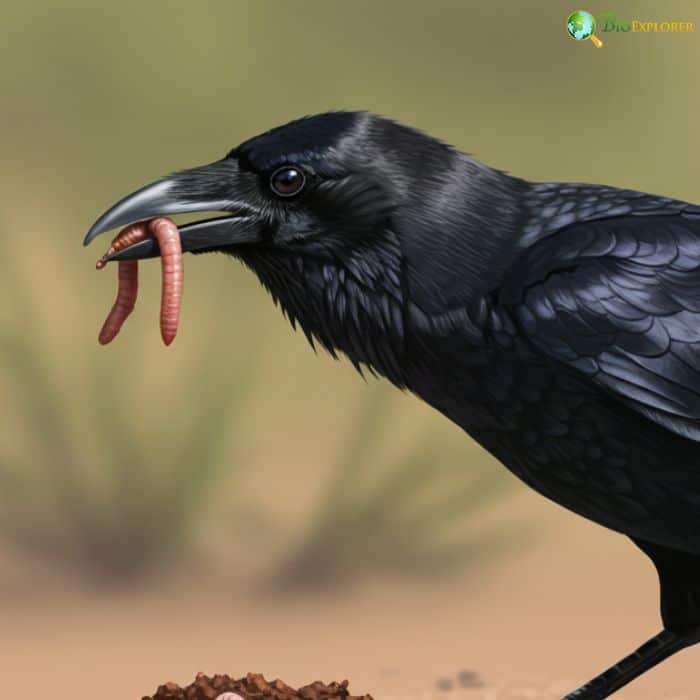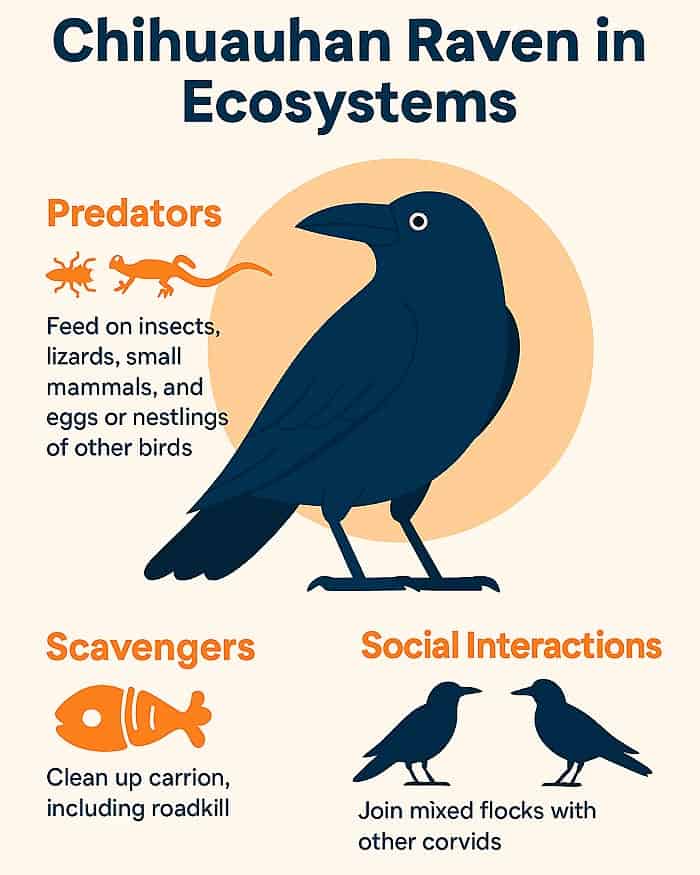
| Animalia | Passeriformes | Corvidae | Corvus | Corvus cryptoleucus |
The Chihuahuan raven (Corvus cryptoleucus) is a medium-sized corvid native to the southwestern United States and parts of Mexico. Among the types of crows, it stands out for its intelligence and adaptability to the arid landscapes it calls home. Formerly known as the American white-necked raven, this bird is well-suited to desert life.
The Chihuahuan raven is slightly smaller than its cousin, the Common Raven, but larger than an American Crow, occupying a unique ecological niche in dry grasslands and desert scrub environments. Among the many kinds of birds found in arid regions, these ravens stand out for their exceptional intelligence and playful behavior, demonstrating complex problem-solving abilities and social interactions.
In places like White Sands National Park, these glossy black birds can be seen soaring above the landscape, playing in the wind, or perched on bushes and utility poles, making them a common sight for visitors to southwestern desert regions.
Table of Contents
- Chihuahuan Raven Characteristics
- Chihuahuan Raven Habitat
- Diet and Hunting Behavior
- Breeding Behavior
- Interactions with Other Wildlife
- Ecological Importance of Chihuahuan Ravens
- Chihuahuan Raven Fun Facts
- Frequently Asked Questions
- Do Chihuahuan ravens migrate?
- Are Chihuahuan ravens noisy?
- Can Chihuahuan ravens be found in cities?
- How do Chihuahuan ravens interact with people?
- What threats do Chihuahuan ravens face?
- Do Chihuahuan ravens have any natural predators?
- Are Chihuahuan ravens monogamous?
- How do Chihuahuan ravens cope with extreme heat?
- Can Chihuahuan ravens mimic sounds?
- What is the best way to observe Chihuahuan ravens?
- Common Name: Chihuahuan Raven.
- Family: Corvidae
- Body Dimensions: Around 20 inches in length, about 40 inches in wingspan.
- Male Plumage Colors: Entirely black.
- Female Plumage Colors: Entirely black.
- Habitat: Arid grasslands, scrub, Yucca flats.
- Diet: Insects, carrion, fruit, seeds.
- Native Countries: United States, Mexico.
- Continents: North America
Chihuahuan Raven Characteristics

The Chihuahuan raven is a large, entirely black bird with a hefty bill and long nasal bristles.
- Measuring between 19-21 inches (48-53 cm) in length, they are comparable in size to an American crow or a Mallard duck.
- These ravens typically weigh between 13 and 23 ounces and have an impressive wingspan of 40 to 43 inches.
- Several subtle yet identifiable characteristics distinguish the Chihuahuan raven from other corvids. Unlike the common raven, the Chihuahuan is slightly smaller and more compact, weighing approximately 1.2 pounds (0.5 kg).
- A key identifying feature is the presence of distinctive white feathers at the base of its neck, which are only visible when the wind ruffles the bird’s feathers or when the bird fluffs itself. This characteristic gave rise to their former name, the American white-necked raven.
The Chihuahuan raven displays a diamond-shaped or wedge-shaped tail and broad, round wings in flight.
- They have a well-developed ruff of feathers called ‘hackles‘ on the throat. The Chihuahuan raven has a stout, heavy bill similar to the common raven but slightly smaller.
- Their entire body is black from beak to feet, except for those hidden white neck feathers.
Another distinguishing characteristic is their voice. While the American crow has a harsh caw and the common raven produces a deep throaty croak, the Chihuahuan raven makes a distinctive deep “kraaa” sound or “puk-pruk” calls. Their vocalizations are harsh “kraak” sounds, higher pitched than the common raven’s calls.
Chihuahuan Raven Habitat

The Chihuahuan raven, one of the characteristic desert birds, thrives in arid and semi-arid environments, primarily inhabiting dry grasslands, scrubland, and yucca flats across the southwestern United States and parts of Mexico. Their distribution spans Arizona, New Mexico, Colorado, Kansas, and Texas, with particular concentration in the southeastern portion of Arizona.
- Unlike the common raven, which can be found in more diverse habitats, including mountains and forests, the Chihuahuan raven generally avoids wooded areas and extreme deserts, preferring the intermediate grassland ecosystems.
- This habitat specialization creates an interesting ecological separation between the two raven species in the southwest: Common Ravens occupy extremely dry areas (desert lowlands) and the wetter areas (mountain forests), while Chihuahuan ravens dominate the grasslands between these extremes.
At White Sands National Park, these ravens have adapted well to the unique gypsum dune environment, where they can be observed soaring above the landscape or perching on bushes and utility poles.
The Chihuahuan raven’s preference for open landscapes extends to human-modified environments, including landfills and dumps where abundant food resources are available.
Most Chihuahuan ravens are permanent residents throughout their range. However, some may withdraw from the northern parts of their territory during the fall. During winter, these birds often form flocks that move around the landscape, gathering in areas with good feeding opportunities.
Diet and Hunting Behavior

The Chihuahuan raven is a highly adaptable omnivore with an opportunistic feeding strategy to thrive in harsh desert environments.
- Their diet is remarkably varied, though it consists primarily of animal matter, including large insects, spiders, earthworms, snails, rodents, lizards, and the eggs and young of other birds.
- These intelligent birds employ several hunting and foraging techniques. They often scan the ground while soaring or from a perched position to locate potential food sources.
- Once prey is spotted, the raven uses its feet to hold the item while pecking it apart with its heavy bill. This technique allows them to efficiently process everything from small mammals to lizards.
Chihuahuan ravens are also well-known scavengers. They frequently patrol highways for roadkill and gather at garbage dumps where food is plentiful.
- In addition to animal matter, Chihuahuan ravens supplement their diet with plant materials including grain, seeds, berries, fruits, and notably, cactus fruit. This dietary flexibility allows them to adapt to seasonal changes in food availability across their arid habitat range.
- Outside of the breeding season, Chihuahuan ravens typically forage in flocks, which may provide advantages in locating food resources and protection from predators.
- This social foraging behavior distinguishes them somewhat from common ravens, as Chihuahuan ravens tend to be more sociable overall.
Breeding Behavior

The Chihuahuan raven has developed unique breeding strategies suited to its desert habitat. These ravens may form loose colonies despite their typically territorial nature in areas with limited nesting sites, especially near the northern range. They usually breed in summer, timing reproduction with seasonal rains that boost food availability.
The female leads the nest building, with both parents contributing to the nesting process. Nests are bulky structures of sticks and thorny twigs, lined with grass, bark fibers, animal hair, and sometimes items like yucca fibers, rags, or barbed wire. Nests are placed 5–40 feet high in trees, yuccas, shrubs, or on human-made structures like utility poles and towers in treeless areas. These nests are often reused annually with minor repairs.
Females lay 3 to 8 eggs, typically 5 to 6, which are pale olive or gray-green with blotches. Incubation lasts 18–21 days and is shared by both parents. After hatching, both bring food to the nestlings. The young fledge after about 28–30 days, a longer nestling period that helps them develop the cognitive and survival skills typical of intelligent corvids.
Interactions with Other Wildlife

The Chihuahuan raven plays a vital role in desert and grassland ecosystems through predation, scavenging, and social interactions.
- As predators, they feed on insects, lizards, small mammals, and the eggs or nestlings of other birds, helping control some populations while occasionally impacting vulnerable species.
- As scavengers, they clean up carrion, including roadkill, reducing disease spread and aiding nutrient recycling. Their presence around carcasses highlights their ecological value in arid landscapes.
- Highly intelligent, Chihuahuan ravens may follow larger predators to scavenge leftovers, forming commensal relationships. Their loud calls can alert other types of animals to danger, acting as natural alarm systems.
In winter, they often join mixed flocks with other corvids, especially American crows, forming temporary alliances that showcase their social complexity. These seasonal groupings and behavioral adaptations underscore the species’ cognitive abilities and ecological importance.
Ecological Importance of Chihuahuan Ravens
The Chihuahuan raven is classified as a species of “Least Concern” with an estimated population of around 840,000.
- While overall numbers remain stable, they’ve declined in parts of their northern range, notably in eastern Colorado and western Kansas. In contrast, they remain abundant across southern areas.
- Their adaptability helps them thrive in both wild and human-altered landscapes. As scavengers and predators, they play key ecological roles in the ecological pyramid by cleaning up carrion and controlling pest populations.
- Climate change presents a future threat, driven in part by rising greenhouse gases, with studies from Audubon’s “Survival by Degrees” project projecting range shifts based on temperature scenarios. These shifts could affect the ravens and other species sharing their habitat.
Conservation efforts focus on preserving desert grasslands and shrublands vital to their survival. As development spreads across the southwestern U. S., protecting large areas of these natural environments is essential to ensure the long-term health of Chihuahuan raven populations.
Chihuahuan Raven Fun Facts
- The Chihuahuan raven was once known as the “American white-necked raven“, a nod to the hidden white feathers at the base of its neck, which are rarely seen unless the wind blows just right or the bird fluffs up.
- These ravens are famous for their playful aerial displays. Observers at White Sands National Park have seen them catching thermals and performing barrel rolls and even flying upside down for short stretches.
- In colder months, Chihuahuan ravens sometimes form massive communal roosts, with hundreds of birds gathering together for warmth and safety.
- Their calls are not just for communication; they use a variety of sounds for play, warnings, and even what appears to be “conversations” with other ravens.
- In areas with few trees, these ravens have been known to nest on telephone poles, windmills, and even abandoned buildings, showing their adaptability to human-altered landscapes.
- Outside of breeding season, they can be seen in flocks that soar together, sometimes engaging in what looks like coordinated group play.
- Chihuahuan ravens are known to investigate novel objects, sometimes carrying off shiny items or bits of trash out of apparent curiosity.
- In the 1800s, they were much more common in the northern parts of their range, such as eastern Colorado and western Kansas, than they are today.
- Their tail, diamondor wedge-shaped in flight, is a unique field mark for birders trying to distinguish them from crows and other ravens.
- At night, they often choose communal roosts in large trees or on man-made structures, sometimes returning to the same spot for years.
Frequently Asked Questions
Do Chihuahuan ravens migrate?
Chihuahuan ravens are generally resident birds, meaning they stay in their home range year-round. However, some individuals may move short distances, especially from the northernmost parts of their range during colder months. Unlike many songbirds, they do not undertake long-distance migrations.
Are Chihuahuan ravens noisy?
Yes, they are quite vocal and use a variety of calls. Their sounds range from harsh “kraaak” calls to softer, more conversational noises. These vocalizations serve multiple purposes, including communication within flocks and warning of predators.
Can Chihuahuan ravens be found in cities?
While they are most common in open grasslands and desert scrub, Chihuahuan ravens are highly adaptable. They can sometimes be found near human settlements, especially where food is available, such as landfills or agricultural areas.
How do Chihuahuan ravens interact with people?
These ravens are known for their curiosity. They may approach people, especially in parks or picnic areas, to investigate for food scraps. They are not typically aggressive but are bold and clever in their search for food.
What threats do Chihuahuan ravens face?
Habitat Loss due to agricultural expansion, urban development, and changes in land use can impact local populations. In some areas, declines have been noted, especially at the northern edge of their range.
Do Chihuahuan ravens have any natural predators?
While adult ravens are rarely prey upon due to their size and intelligence, snakes, hawks, or mammals may take eggs and young. Their communal roosting and nesting behaviors help reduce the risk of predation.
Are Chihuahuan ravens monogamous?
Chihuahuan ravens typically form long-term pair bonds. Mated pairs often remain together year after year, cooperating in nest building, incubation, and raising their young.
How do Chihuahuan ravens cope with extreme heat?
They are well-adapted to desert life, often being most active in the cooler parts of the day and seeking shade or soaring at higher altitudes during the hottest hours.
Can Chihuahuan ravens mimic sounds?
While not as famous for mimicry as some other corvids, Chihuahuan ravens can imitate various sounds, including other birds and even mechanical noises. However, this is less commonly reported than in common ravens.
What is the best way to observe Chihuahuan ravens?
Look for them soaring over open country, perched on utility poles, or foraging in groups in grassland and desert areas. Early morning and late afternoon are often the best times for observation, especially where food or water is present.
The Chihuahuan raven is a remarkable example of adaptation to the challenging environments of southwestern deserts and grasslands. Though often overshadowed by its larger cousin, the Common raven, this intelligent corvid possesses unique characteristics that make it a fascinating subject of study.
From its distinctive white neck feathers to its playful behavior and complex social structures, the Chihuahuan raven demonstrates the remarkable evolutionary adaptations that allow wildlife to thrive in seemingly harsh conditions.
![]()











